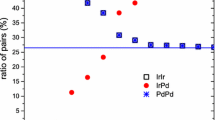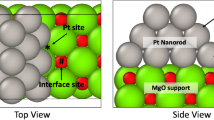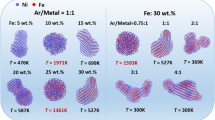Abstract
Chemical equilibrium involving a small number of molecules inside a confined nanospace can exhibit considerable deviations from the macroscopic thermodynamic limit due to reduced mixing entropy, as was predicted in several of our works using statistical-mechanics partition-functions and the lattice-gas model (LGM). In particular, significant enhancements of the equilibrium extent and constant are generally anticipated in the case of exothermic reactions. The present work is a substantial extension of this exploration of the so-called “nanoconfinement entropic effect on chemical equilibrium” (NCECE), focusing now on several new issues: (i) general derivation and computations for addition reactions in the non-lattice model (NLM), including endergonic reactions exhibiting significantly weakened NCECE, (ii) comparison with effects predicted for dimerization reactions, for which a novel “inverse NCECE” is obtained for the endergonic range, (iii) a concrete system modeling of Ir dimerization in the core of Pd–Ir cuboctahedral nanoparticles using uniform bond energetics in the LGM versus the NLM. The latter reproduces quite accurately the NCECE effects obtained by the LGM, thus avoiding tedious combinatorial computations, and (iv) Ir dimerization at subsurface sites of the Pd nanoparticles in the framework of the LGM with a more elaborate coordination-dependent bond energetics. It should be noted that the latter subsurface compositional variations can affect catalytic properties of Pd–Ir nanoparticles such as those operating in several applications.






Similar content being viewed by others
References
Polak M, Rubinovich L (2008) Nanochemical equilibrium involving a small number of molecules: a prediction of a distinct confinement effect. Nano Lett 8(10):3543–3547. https://doi.org/10.1021/nl801825q
Polak M, Rubinovich L (2011) Remarkable nanoconfinement effects on chemical equilibrium manifested in nucleotide dimerization and H-D exchange reactions. Phys Chem Chem Phys 13(37):16728–16734. https://doi.org/10.1039/c1cp21719d
Renou R, Szymczyk A, Maurin G, Malfreyt P, Ghoufi A (2015) Superpermittivity of nanoconfined water. J Chem Phys. https://doi.org/10.1063/1.4921043
Schlaich A, Knapp EW, Netz RR (2016) Water dielectric effects in planar confinement. Phys Rev Lett. https://doi.org/10.1103/PhysRevLett.117.048001
Schaaf C, Gekle S (2016) Spatially resolved dielectric constant of confined water and its connection to the non-local nature of bulk water. J Chem Phys. https://doi.org/10.1063/1.4960775
Munoz-Santiburcio D, Marx D (2017) Chemistry in nanoconfined water. Chem Sci 8(5):3444–3452. https://doi.org/10.1039/c6sc04989c
Polak M, Rubinovich L (2015) Nanoconfined nitrogen hydrogenation on Ru(0001): prediction of entropy related shifts in the reaction equilibria. Surf Sci 641:294–299. https://doi.org/10.1016/j.susc.2015.03.002
Polak M, Rubinovich L (2017) Prediction of enhanced dimerization inside dilute alloy nanoparticles. Int J Nanomater Nanotechnol Nanomed 3(1):023–026
Hill TL (1994) Thermodynamics of small systems. Dover Publications, New York
García-Morales V (2011) Nanothermodynamics. In: Sattler KD (ed) Handbook of nanophysics: principles and methods, vol 1.CRC Press Inc, Boca Raton, FL
Turner CH, Johnson JK, Gubbins KE (2001) Effect of confinement on chemical reaction equilibria: the reactions 2NO ↔ (NO)2 and N2 + 3H2 ↔ 2NH3 in carbon micropores. J Chem Phys 114(4):1851–1859. https://doi.org/10.1063/1.1328756
Malijevsky A, Lisal M (2009) Density functional study of chemical reaction equilibrium for dimerization reactions in slit and cylindrical nanopores. J Chem Phys. https://doi.org/10.1063/1.3125925
Turner CH, Brennan JK, Lisal M, Smith WR, Johnson JK, Gubbins KE (2008) Simulation of chemical reaction equilibria by the reaction ensemble Monte Carlo method: a review. Mol Simul 34(2):119–146. https://doi.org/10.1080/08927020801986564
Patra S, Naik AN, Pandey AK, Sen D, Mazumder S, Goswami A (2016) Silver nanoparticles stabilized in porous polymer support: a highly active catalytic nanoreactor. Appl Catal A 524:214–222. https://doi.org/10.1016/j.apcata.2016.07.001
Patra S, Pandey AK, Sen D, Ramagiri SV, Bellare JR, Mazumder S, Goswami A (2014) Redox decomposition of silver citrate complex in nanoscale confinement: an unusual mechanism of formation and growth of silver nanoparticles. Langmuir 30(9):2460–2469. https://doi.org/10.1021/la4048787
Shi L, Wu CY, Ding J (2016) Effect of solvent on the synthesis of AgBiSe2 nanostructures. J Alloy Compd 684:112–115. https://doi.org/10.1016/j.jallcom.2016.05.180
Szymanski R, Sosnowski S, Maslanka L (2016) Statistical effects related to low numbers of reacting molecules analyzed for a reversible association reaction A plus B = C in ideally dispersed systems: an apparent violation of the law of mass action. J Chem Phys. https://doi.org/10.1063/1.4944695
Laurenzi IJ (2000) An analytical solution of the stochastic master equation for reversible bimolecular reaction kinetics. J Chem Phys 113(8):3315–3322. https://doi.org/10.1063/1.1287273
McQuarrie DA, Jachimowski C, Russell M (1964) Kinetics of small systems. II. J Chem Phys 40(10):2914–2921
Ishida K (1964) Stochastic model for bimolecular reaction. J Chem Phys 41(8):2472–2478
Gillespie DT (1977) Exact stochastic simulation of coupled chemical-reactions. J Phys Chem 81(25):2340–2361. https://doi.org/10.1021/j100540a008
Rubinovich L, Polak M (2013) The intrinsic role of nanoconfinernent in chemical equilibrium: evidence from DNA hybridization. Nano Lett 13(5):2247–2251. https://doi.org/10.1021/nl4008198
Koblenz TS, Wassenaar J, Reek JNH (2008) Reactivity within a confined self-assembled nanospace. Chem Soc Rev 37(2):247–262
Shon MJ, Cohen AE (2012) Mass action at the single-molecule level. J Am Chem Soc 134(44):14618–14623. https://doi.org/10.1021/ja310275g
Nilekar AU, Ruban AV, Mavrikakis M (2009) Surface segregation energies in low-index open surfaces of bimetallic transition metal alloys. Surf Sci 603(1):91–96. https://doi.org/10.1016/j.susc.2008.10.029
Rubinovich L, Polak M (2009) Prediction of distinct surface segregation effects due to coordination-dependent bond-energy variations in alloy nanoclusters. Phys Rev B. https://doi.org/10.1103/PhysRevB.80.045404
Davis JBA (2014) Private communication
Shen SY, Zhao TS, Xu JB (2010) Carbon-supported bimetallic Pdlr catalysts for ethanol oxidation in alkaline media. Electrochim Acta 55(28):9179–9184. https://doi.org/10.1016/j.electacta.2010.09.018
Morfin F, Nassreddine S, Rousset JL, Piccolo L (2012) Nanoalloying effect in the preferential oxidation of CO over Ir-Pd catalysts. ACS Catal 2(10):2161–2168. https://doi.org/10.1021/cs3003325
Zlotea C, Morfin F, Nguyen TS, Nguyen NT, Nelayah J, Ricolleau C, Latroche M, Piccolo L (2014) Nanoalloying bulk-immiscible iridium and palladium inhibits hydride formation and promotes catalytic performances. Nanoscale 6(17):9955–9959. https://doi.org/10.1039/c4nr02836h
Lopez-De Jesus YM, Johnson CE, Monnier JR, Williams CT (2010) Selective hydrogenation of benzonitrile by alumina-supported Ir-Pd catalysts. Top Catal 53(15–18):1132–1137. https://doi.org/10.1007/s11244-010-9546-0
Rocha AS, Moreno EL, da Silva GPM, Zotin JL, Faro AC (2008) Tetralin hydrogenation on dealuminated Y zeolite-supported bimetallic Pd-Ir catalysts. Catal Today 133:394–399. https://doi.org/10.1016/j.cattod.2007.12.099
Piccolo L, Nassreddine S, Aouine M, Ulhaq C, Geantet C (2012) Supported Ir-Pd nanoalloys: size-composition correlation and consequences on tetralin hydroconversion properties. J Catal 292:173–180. https://doi.org/10.1016/j.jcat.2012.05.010
Hill TL (1986) An introduction to statistical thermodynamics. Courier Dover Publications, Dover
Kolb B, Mueller S, Botts DB, Hart GLW (2006) Ordering tendencies in the binary alloys of Rh, Pd, Ir, and Pt: density functional calculations. Phys Rev B. https://doi.org/10.1103/PhysRevB.74.144206
Barcaro G, Fortunelli A, Polak M, Rubinovich L (2011) Patchy multishell segregation in Pd-Pt alloy nanoparticles. Nano Lett 11(4):1766–1769. https://doi.org/10.1021/nl200322s
Brown D, Quinn PD, Woodruff DP, Noakes TCQ, Bailey P (2002) Surface and sub-surface segregation at the Pt25Rh75(111) surface: a medium energy ion scattering study. Surf Sci 497(1–3):1–12
Treglia G, Legrand B, Ducastelle F (1988) Segregation and ordering at surfaces of transition-metal alloys—the tight-binding Ising-model. Europhys Lett 7(7):575–580
Bligaard T, Norskov JK (2007) Ligand effects in heterogeneous catalysis and electrochemistry. Electrochim Acta 52(18):5512–5516. https://doi.org/10.1016/j.electacta.2007.02.041
Stephens IEL, Bondarenko AS, Perez-Alonso FJ, Calle-Vallejo F, Bech L, Johansson TP, Jepsen AK, Frydendal R, Knudsen BP, Rossmeisl J, Chorkendorff I (2011) Tuning the activity of Pt(111) for oxygen electroreduction by subsurface alloying. J Am Chem Soc 133(14):5485–5491. https://doi.org/10.1021/ja111690g
Acknowledgements
We are thankful to Jack Davis for providing DFT data for the Pd and Ir CBEV parametrization.
Author information
Authors and Affiliations
Corresponding author
Rights and permissions
About this article
Cite this article
Rubinovich, L., Polak, M. Remarkable NanoConfinement Effects on Equilibrated Reactions: Statistical-Mechanics Modeling Focused on Ir Dimerization Beneath Surface Sites in Pd–Ir Nanoparticles. Top Catal 61, 1237–1246 (2018). https://doi.org/10.1007/s11244-018-0978-2
Published:
Issue Date:
DOI: https://doi.org/10.1007/s11244-018-0978-2




